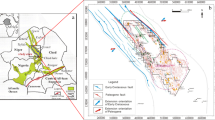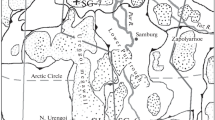Abstract
It is demonstrated by various geochemical indexes that the Zhengjia-Wangzhuang Oilfield with viscous crude oil in the Jiyang Depression has been sourced from the contribution of matured source rocks in the upper Es4. The principal cause leading to the densification of crude oils would be biodegradation, with the degradation level of crude oils being ranked as 2–8; vertically, the biodegradation level increases from the top to bottom of the oil column, with a distinctive biodegradation gradient occurring. Calculated parameters of sterane, terpane and methyl-phenanthrene have indicated that the source-rock’s maturity of crude oils and asphaltic sands ranges from 0.7 to 0.9, and based on the calculation of Easy Ro model, the temperature of hydrocarbon generation in the source rock would be within 120–140°C, which coincides with the measurements of reservoir inclusions. The measured homogenization temperature would represent the generation temperature of the source rock, and be fairly different from that of reservoir while being charged with hydrocarbons, which reflects the hydrocarbon-charging to be a fast process, and the period of pool-formation to be consistent with that of peaked generation. According to the evaluation of generation history, the pool-formation could have been occurring in 7–15 Ma. And the biodegradation of crude oils in the study area would be considered to take place in 4–15 Ma based on the examination of biodegradation order and dynamic calculations.
Similar content being viewed by others
References
Larter, S., Wilhelms, A., Head, I. et al., The controls on the composition of biodegraded oils in the deep subsurface, Part 1, Biodegradation rates in petroleum reservoirs, Organic Geochemistry, 2003, 34: 601–613.
Roadifer, R. E., Size distribution of world’s largest known oil and tar accumulation, in Exploration for Heavy Oil and Natural Bitumen, AAPG Studies in Geology, Vol. 25 (ed. Meyer, R. F.), Tulsa: American Association of Petroleum Geologists, 1987, 3–23.
Evans, C. R., Rogers, M. A., Bailey, N. J. L., Evolution and alteration of petroleum in Western Canada, Chemical Geology, 1971, 8: 147–170.
Connan, J., Biodegradation of crude oils in reservoirs, in Advances in Petroleum Geochemistry 1 (eds. Brooks, J., Welte, D. H.), London: Academic Press, 1984, 299–335.
Volkman, J. K., Biodegradation of aromatic hydrocarbons in crude oils from the Barrow Sub-basin of Western Australia, Organic Geochemistry, 1984, 6: 619–632.
Peters, K. E., Moldowan, J. M., The Biomarkers Guide: Interpreting Molecular Fossils in Petroleum and Ancient Sediments, New Jersey: Prentice Hall, Englewood Cliffs, 1993.
Moldowan, J. M., McCaffrey, M. A., A novel microbial hydrocarbon degradation pathway revealed by hopane demethylation in a petroleum reservoir, Geochimica et Cosmochimica Acta, 1995, 59(9): 1991–1994.
Koopmans, M. P., Larter, S. R., Zhang, C. et al., Biodegradation and mixing of crude oils in Eocene Es3 reservoirs of the Liaohe Basin, northeastern China, AAPG Bulletin, 2002, 86(10): 1833–1843.
Jones, D. M., Douglas, A. G., Parkes, R. J. et al., The recognition of biodegraded petroleum-derived aromatic hydrocarbons in recent marine sediments, Marine Pollution Bulletin, 1983, 14: 103–108.
Gough, M. A., Rowland, S. J., Characterization of unresolved complex mixtures of hydrocarbons in petroleum, Nature, 1990, 334: 648–650.
Peters, K. E., Moldowan, J. M., Effects of source, thermal maturity, and biodegradation on the distribution and isomerization of homohopanes in petroleum, Organic Geochemistry, 1991, 17: 47–61.
Matyasik, I., Steczko, A., Philp, R. P., Biodegradation and migrational fractionation of oils from the Eastern Carpathians, Poland, Organic Geochemistry, 2000, 31: 1509–1523.
Seifert, W. K., Moldowan, J. M., The effect of biodegradation on steranes and terpanes in crude oils, Geochimica et Cosmochimica Acta, 1979, 43: 111–126.
Seifert, W. K., Moldowan, J. M., Demaison, G. J., Source correlation of biodegraded oils, Organic Geochemistry, 1984, 6: 633–643.
Rullkötter, J., Wendisch, D., Microbial alteration of 17α(H)-hopane in Madagascar asphalts: Removal of C-10 methyl group and ring opening, Geochimica et Cosmochimica Acta, 1982, 46: 1543–1553.
Mazeas, L., Budzinski, H., Raymond, N., Absence of stable carbon isotope fractionation of saturated and polycyclic aromatic hydrocarbon during aerobic bacterial biodegradation, Organic Geochemistry, 2002, 33: 1259–1272.
Huang, H., Bowler, B. F. J., Zhang, Z. et al., Influence of biodegradation on carbazole and benzocarbazole distributions in oil columns from the Liaohe Basin, NE China, Organic Geochemistry, 2003, 34: 951–969.
Zhang, D., Huang, D., Li, J., Biodegraded sequence of Karamay oils and semi-quantitative estimation of their biodegraded degrees in Junggar Basin China, Organic Geochemistry, 1988, 13: 295–302.
Jobson, A. M., Cook, F. D., Westlake, D. W. S., Interaction of aerobic and anaerobic bacteria in petroleum biodegradation, Chemical Geology, 1979, 24: 355–365.
Horstad, I., Larter, S. R., Mills, N., A quantitative model of biological petroleum degradation within the Brent Group reservoir in the Gullfaks field, Norwegian North Sea, Organic Geochemistry, 1992, 19: 107–117.
Rueter, P., Rabus, R., Wilkes, H. et al., Anaerobic oxidation of hydrocarbons in crude oil by new types of sulphate reducing bacteria, Nature, 1994, 372: 455–458.
Hunkeler, D., Jorger, D., Haberli, K. et al., Petroleum hydrocarbon mineralization in anaerobic laboratory aquifer columns, Journal of Contaminant Hydrology, 1998, 32: 41–61.
Zengler, K., Richnow, H. R., Rossello-Moro, R. et al., Methane formation from long-chain alkanes by anaerobic microorganisms, Nature, 1999, 401: 266–269.
Widdel, F., Rabus, R., Anaerobic biodegradation of saturated and aromatic hydrocarbons, Current Opinions in Biotechnology, 2001, 12: 259–276.
Wilhelms, A., Larter, S. R., Head, I. et al., Biodegradation of oil in uplifted basins prevented by deep-burial sterilization, Nature, 2001, 411: 1034–1037.
Chen Jianyu, Li Yongfu, Tian Bo et al., Origin of viscous oil in the Kenxi-Luojia oilfield, Oil and Gas Geology (in Chinese), 1998, 19 (3): 245–253.
Zhang Linye, Zhang Chunrong, Generation Mechanism for Immature Oil and Oil-Generating System, the Southern Slope of the Niuzhuang Sag in the Jiyang Depression As An Example (in Chinese), Beijing: Geological Press, 1999, 1–36.
Zhang Linye, Zhang Shouchun, Huang Kaiquan et al., Simulation experiment of immature oil genetic mechanism in lake facies of semi-salt water, Chinese Science Bulletin, 1999, 44(11): 980–988.
Liu Jiaduo, Tian Jingchun, Li Qi, Research on the regularity of petroleum migration and concentration in Luojia nose-like structure in the Zhanhua Sag, Journal of Chengdu University of Science and Technology (in Chinese), 2000, 27(2): 111–115.
Zhang Linye, Kong Xiangxing, Zhang Chunrong, Development and its significance of high-quality source rock in the Paleogene of the Jiyang Depression, Geochemistry (in Chinese), 2003, 32(1): 35–42.
Zhang Linye, Jiang Youlu, Liu Hua et al., Oil source character analyzing of Dongying Depression, Oil and Gas Exploration and Development (in Chinese), 2003, 30(3): 61–64.
Qiu Yinan, Xue Shuhao, Evaluation Technique for Oil and Gas Reservoirs (in Chinese), Beijing: Oil Industrial Press, 1994, 251–257.
Guo Suiping, Shi Xiaobin, Wang Liangshu et al., Analysis of thermal history in the Dongying Depression of the Shengli oil region-evidence of fission track of phosphorite, Oil and Gas Geology (in Chinese), 1996, 17(1): 32–36.
Author information
Authors and Affiliations
Corresponding author
About this article
Cite this article
Wang, Z., Peng, P., Yu, C. et al. Pool-formation and secondary change of biodegraded viscous oils: Case study of reservoir section in the Zhengjia-Wangzhuang Oilfield, Jiyang Depression. Chin. Sci. Bull. 49 (Suppl 1), 39–49 (2004). https://doi.org/10.1007/BF02890452
Received:
Accepted:
Issue Date:
DOI: https://doi.org/10.1007/BF02890452




